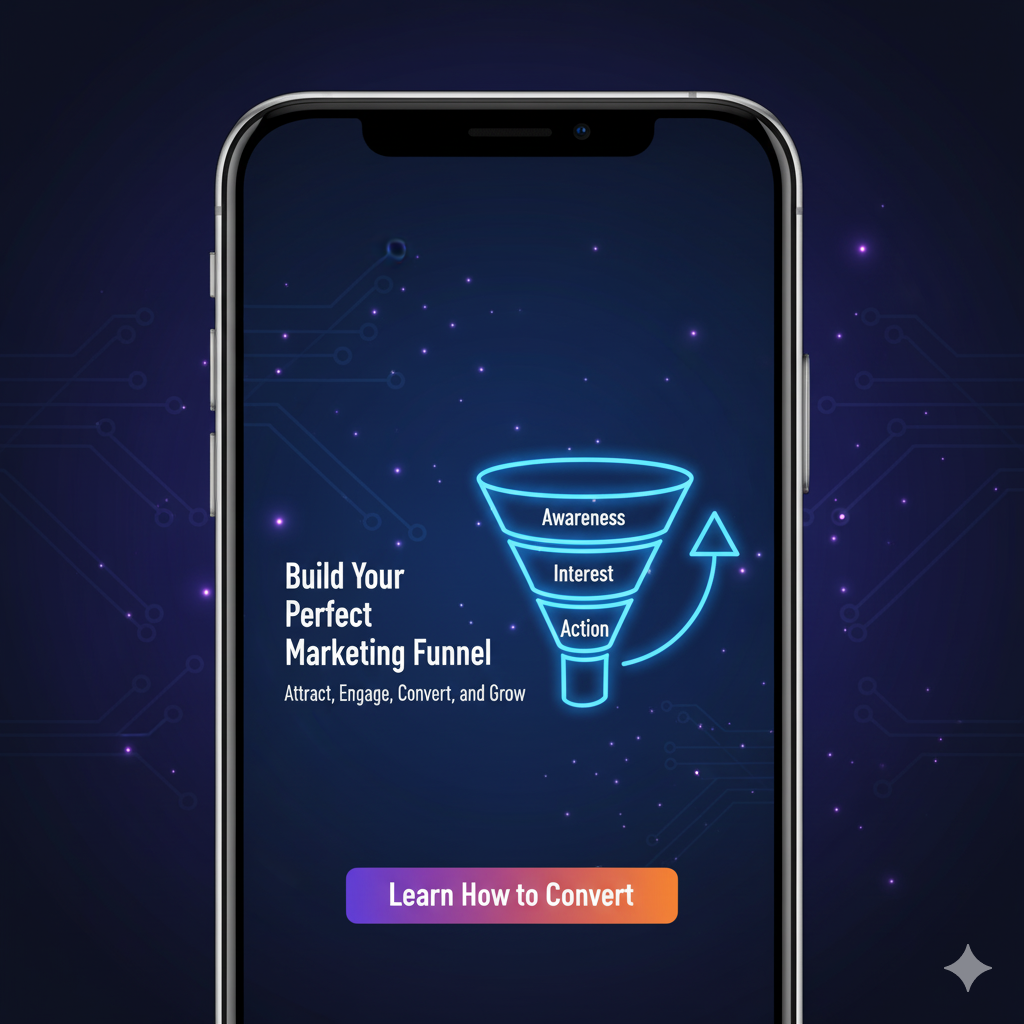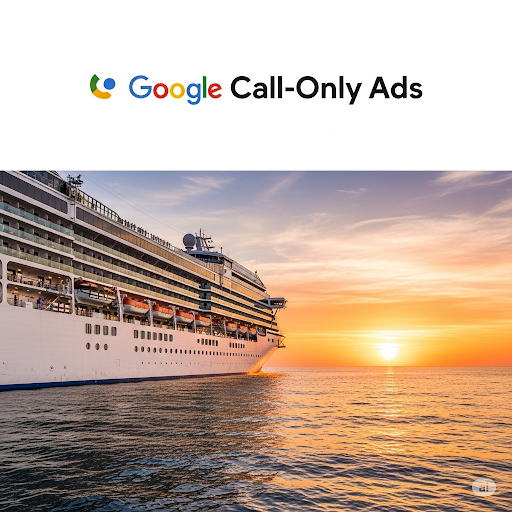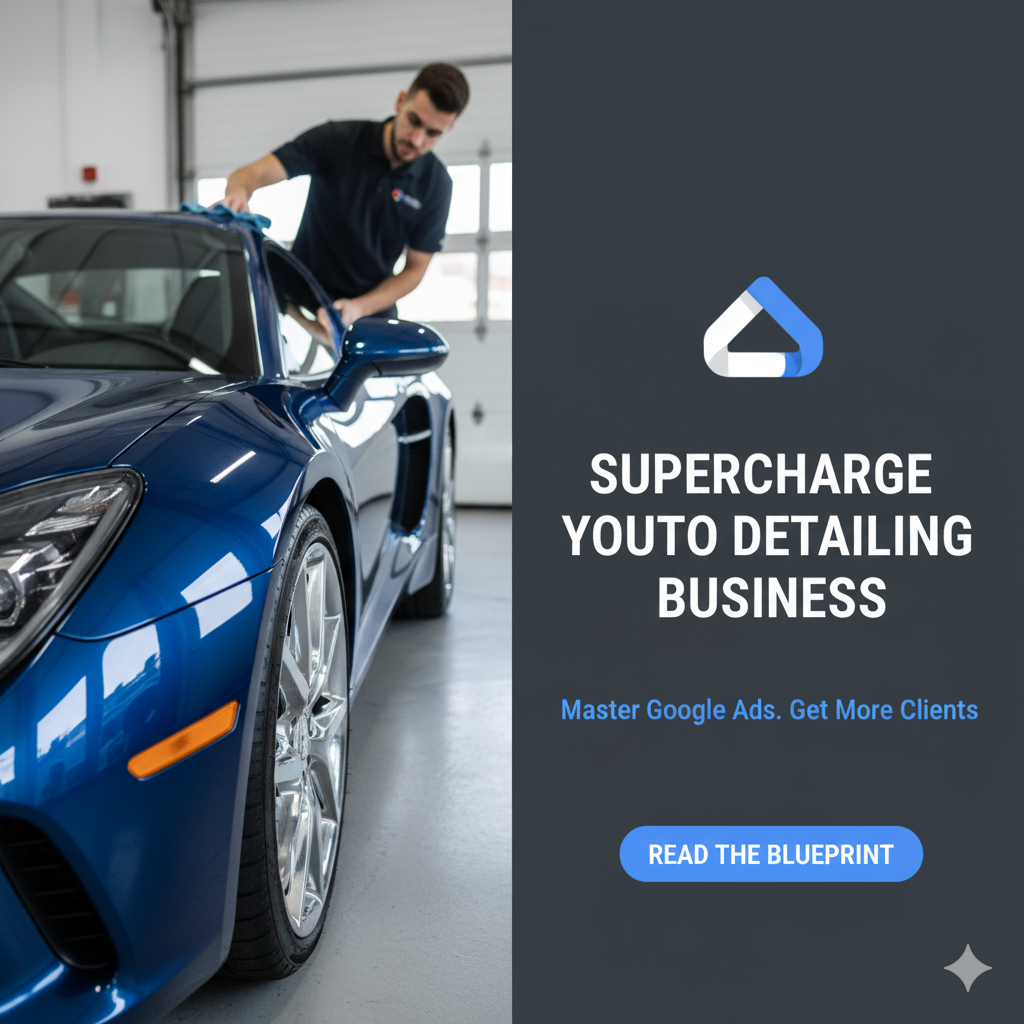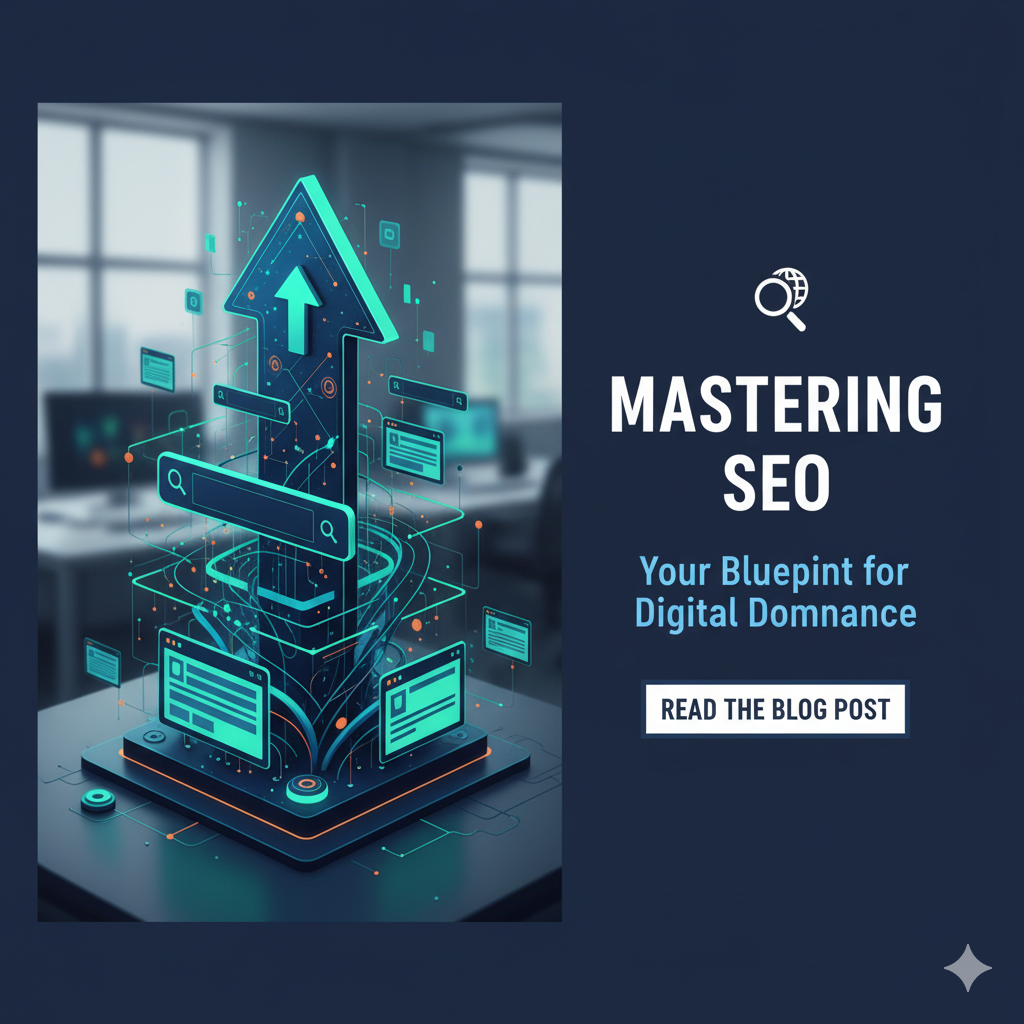Unlock the Power of a High-Converting Marketing Funnel
In today’s digital world, having a website is not enough. Businesses need a structured way to attract, engage, and convert leads into paying customers. That’s where a marketing funnel comes in. A well-designed marketing funnel guides your audience step by step—from discovering your brand to becoming loyal customers—while maximizing conversions and profitability.
At our agency, we specialize in marketing funnel design services tailored to your business goals. Whether you’re a small business owner, e-commerce brand, coach, or service provider, we create customized sales funnels that bring you measurable results.
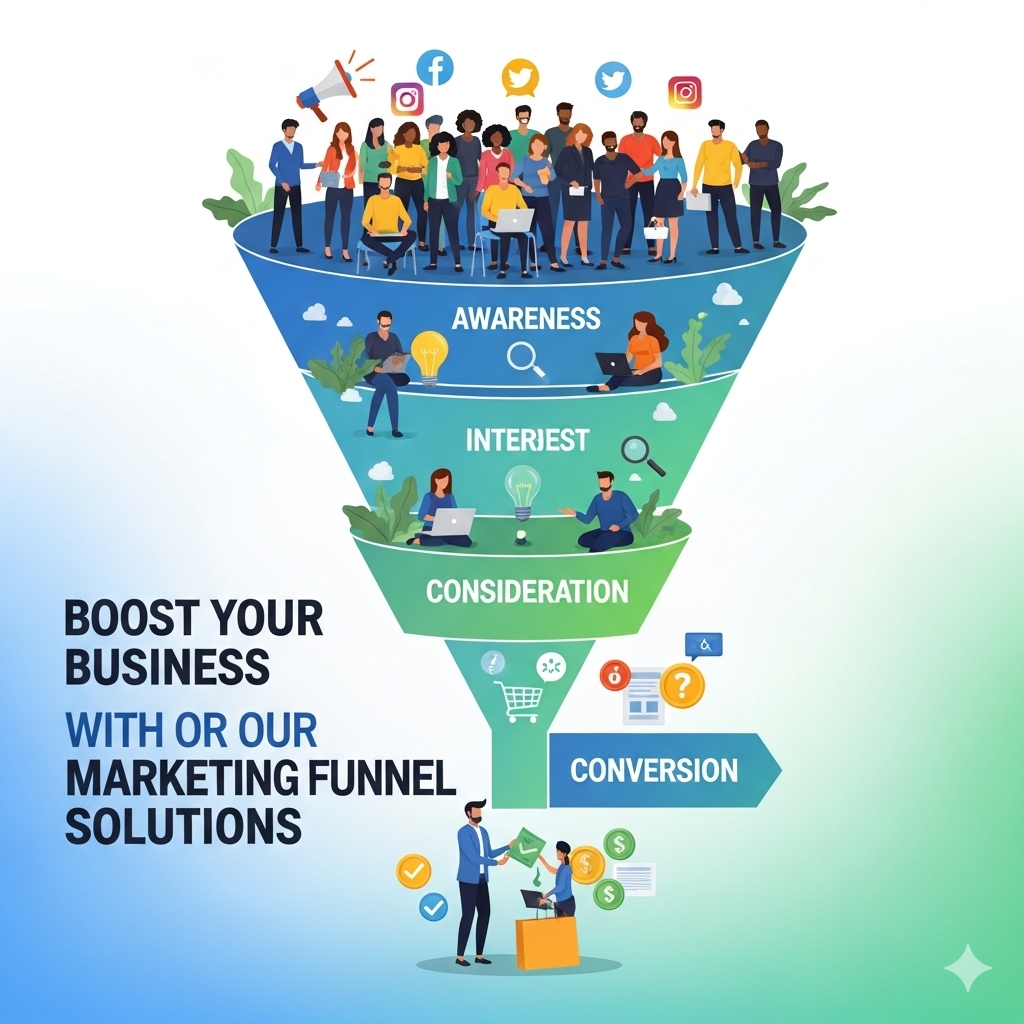
What is a Marketing Funnel?
A marketing funnel (also called a sales funnel) is a structured customer journey that leads potential clients from awareness to conversion. Unlike a standard website, a funnel is designed with one clear objective: turning visitors into leads and leads into customers.
Instead of overwhelming visitors with too many options, a funnel provides a smooth, guided path. From offering a free lead magnet to building trust through email automation and finally presenting upsell opportunities, every step is intentional and conversion-driven.
Why Your Business Needs a Marketing Funnel
- Higher Conversions: Funnels eliminate distractions and keep visitors focused on one action at a time.
- Automated Lead Nurturing: Through email sequences and automation, you engage prospects 24/7.
- Increased Revenue: Upsell and downsell offers maximize the value of each customer.
- Scalable Growth: Once your funnel works, you can drive traffic through ads and watch conversions grow consistently.
If you rely only on a website, you’re likely missing out on significant revenue opportunities. A sales funnel ensures no lead falls through the cracks.
Our Marketing Funnel Design Services
We don’t believe in one-size-fits-all funnels. Every business is unique, and so is every funnel we design. Here’s what we include in our marketing funnel services:
1. Business Analysis & Funnel Strategy
Before designing, we analyze your business model, audience, and competitors. We then outline a custom funnel strategy that matches your goals—whether that’s generating leads, selling products, or booking consultations.
2. Lead Magnet Creation
The first step in any marketing funnel is capturing attention. We design lead magnets (ebooks, guides, checklists, free trials, webinars) that provide value and encourage visitors to share their contact details. This builds your email list with qualified leads.
3. High-Converting Sales Page
Once leads are captured, they need to be guided toward making a purchase. We build persuasive sales pages that highlight your product or service benefits, showcase testimonials, and include powerful calls-to-action. Each sales page is optimized for both desktop and mobile.
4. Thank-You Page & Cross-Selling
Many businesses underestimate the importance of a thank-you page. We design thank-you pages that don’t just say “thank you,” but also:
- Reinforce brand trust
- Offer next steps
- Introduce cross-sell or downsell offers
This turns a simple “thank you” into another conversion opportunity.
5. Email Automation & Follow-Ups
Not every lead converts immediately. That’s why we build email automation systems to nurture prospects. Using tools like Mailchimp, ActiveCampaign, or Systeme.io, we set up sequences that build trust, educate leads, and move them closer to purchasing.
6. Upsell & Downsell Offers
Increasing average order value is key to scaling. We strategically design upsell offers (premium or add-on products) and downsell offers (affordable alternatives) to capture more revenue without increasing ad spend.
7. Analytics & Optimization
Finally, we set up tracking and analytics to measure funnel performance. By analyzing conversion rates, open rates, and sales data, we continually optimize your funnel for maximum profitability.
Stages of a Marketing Funnel
A marketing funnel is the backbone of any successful online business. Unlike a simple website, it provides a structured journey that takes a stranger from being “aware” of your brand all the way to becoming a loyal, repeat customer. To truly unlock the power of a sales funnel, it’s important to understand each stage and how it contributes to conversions and long-term profitability.
Awareness Stage – Lead Magnet
The first stage of any marketing funnel is awareness. At this point, your potential customer has just discovered your business. They may not know much about your products or services yet, so the goal here is to provide something of value for free—commonly known as a lead magnet.
A lead magnet could be an ebook, a free guide, a webinar, a discount coupon, or even a checklist that solves a small problem for your audience. In exchange, the visitor shares their contact information, usually an email address.
The importance of this stage cannot be overstated. By offering genuine value upfront, you are not just attracting attention—you’re building trust. This stage also helps you grow your email list with qualified leads who are more likely to engage with your brand in the future.
Consideration Stage – Sales Page
Once you have captured a lead, the next step is the consideration stage. This is where you present your main offer through a well-designed sales page.
A sales page is not just about listing features; it’s about showing prospects why your solution is the best choice for them. It must highlight the benefits of your product or service, address common objections, and showcase social proof like testimonials, reviews, or case studies.
The design and messaging of a sales page play a huge role in conversions. High-quality visuals, persuasive copywriting, and a clear call-to-action (CTA) can make the difference between a lead bouncing away and one who becomes a paying customer.
Conversion Stage – Thank-You Page & Checkout
The third stage is conversion. After someone makes a purchase or signs up, they are directed to a thank-you page. While many businesses treat this as a simple “confirmation,” it’s actually a golden opportunity.
A well-crafted thank-you page reassures customers that their action was successful, but it can also introduce upsell or downsell offers. For example, if someone buys an online course, the thank-you page might offer them a discounted upgrade or a related add-on product.
This stage is not just about saying “thank you”—it’s about increasing the customer lifetime value (CLV) and ensuring customers feel confident about their decision.
Retention Stage – Email Automation
Not all leads convert immediately, which is why email automation is a vital stage of the funnel. Through scheduled follow-up emails, case studies, product tips, and personalized recommendations, you can nurture leads until they are ready to buy.
For existing customers, email automation also strengthens brand loyalty. By continuing to provide value after the purchase—such as tutorials, updates, or exclusive offers—you increase the chances of repeat business. In many industries, email follow-ups generate more revenue than the initial sale itself.
Revenue Maximization – Upsell & Downsell
The final stage of the funnel focuses on revenue maximization. This is where you strategically introduce upsell and downsell offers to make the most out of every customer interaction.
- Upsell Offers: A higher-value product or premium upgrade. Example: If a customer buys a basic subscription, offer them a premium plan with advanced features.
- Downsell Offers: A lower-cost alternative for customers hesitant to spend more. Example: If they don’t want the $97 course, offer a smaller $27 guide.
These offers increase your average order value (AOV) and ensure that you are maximizing profitability without needing to spend more on acquiring new leads.
Final Thoughts
Every stage of a marketing funnel—from the lead magnet at the awareness stage to upsells and downsells at the revenue maximization stage—plays a critical role in turning cold traffic into loyal customers. By designing funnels with these stages in mind, you create a customer journey that feels natural, builds trust, and drives long-term growth.
A business without a funnel is like a shop without a checkout counter—you may get visitors, but you’ll miss out on sales. With a well-structured sales funnel, however, every step your customer takes brings them closer to conversion and repeat purchases.
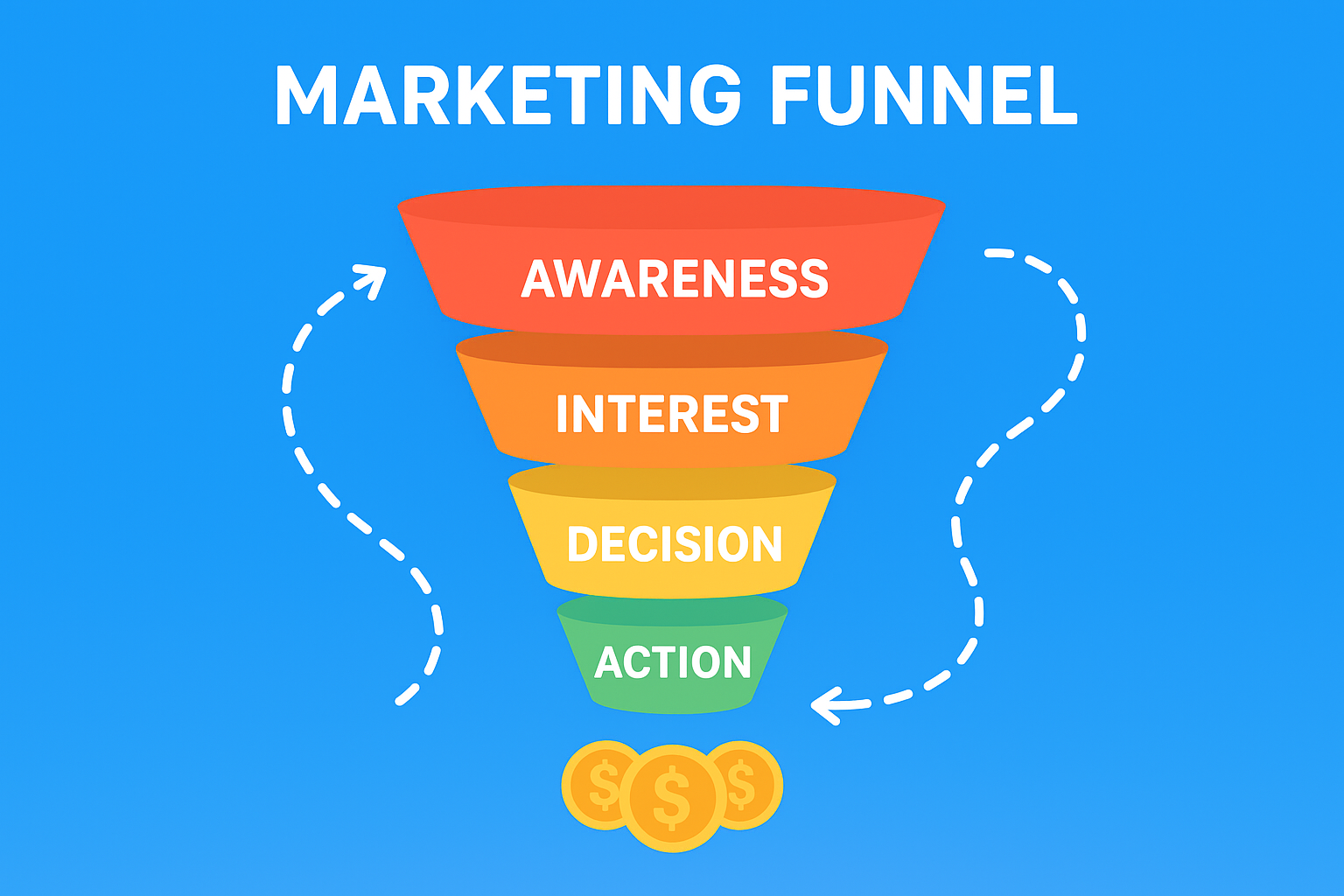
Common Mistakes to Avoid in Marketing Funnel Design
Designing a high-converting marketing funnel requires strategy, precision, and an understanding of customer behavior. Even if you have the best product or service, a poorly structured funnel can burn your ad spend, confuse your audience, and drastically reduce conversions. Many businesses dive into funnel building with enthusiasm but unknowingly make mistakes that weaken their sales process. Below, we’ll break down the most common mistakes to avoid when designing your marketing funnel—and how to fix them.
1. Choosing the Wrong Platform
One of the biggest mistakes is starting with the wrong funnel-building platform. Business owners often choose a tool based on cost or popularity without checking whether it supports their growth goals.
For example:
- Some platforms don’t allow upsells and downsells, limiting your ability to maximize order value.
- Others lack email automation or CRM integrations, forcing you to manually manage leads.
- Cheap tools may not scale as your traffic and sales grow, leading to migration headaches later.
The right funnel platform should provide scalability, analytics, integrations (payment gateways, email, CRM), and flexibility. Selecting the wrong one can make your funnel fragile and difficult to optimize.
2. Overcomplicated Funnels
A funnel should guide prospects smoothly toward conversion, but many businesses add unnecessary steps that confuse users. For instance, a funnel with five or six different pages before checkout can lose buyers due to friction.
Remember: Simplicity converts.
- A clear lead magnet landing page should directly capture emails without extra distractions.
- A sales page should focus on one main offer instead of mixing multiple CTAs.
- Checkout should be seamless with as few clicks as possible.
Clarity and simplicity always outperform complexity.
3. Generic Sales Pages
Another common pitfall is relying on copy-pasted templates without customization. While templates can save time, they’re only effective when adapted to your brand and target audience.
Generic sales pages often lack:
- Personalized messaging that speaks to your customer’s pain points.
- Proof elements such as testimonials, case studies, and reviews.
- Compelling copywriting that highlights your unique value.
A sales page is where your customer decides whether to trust you or not. If it feels bland, irrelevant, or cookie-cutter, conversions will plummet. Investing in strong copy, visuals, and proof elements makes all the difference.
4. Not Testing Offers
Even the most beautiful funnel won’t convert if the offer itself is weak. Businesses often spend weeks designing funnels but skip testing whether their lead magnet or upsell resonates with their audience.
Examples of weak offers include:
- Lead magnets that are too generic (e.g., “Free eBook” without specific value).
- Upsells that feel irrelevant to the main purchase.
- Discounts that don’t create urgency or perceived value.
The best funnels test multiple offers—different headlines, pricing structures, and value propositions. With A/B testing, you can identify what resonates most with your audience and steadily increase conversions.
5. Ignoring Mobile Optimization
Today, the majority of traffic comes from mobile devices. A funnel that looks great on desktop but is clunky on mobile can instantly kill conversions.
Common mobile mistakes include:
- Pages that load too slowly.
- Buttons that are too small or hard to click.
- Check out forms that are difficult to fill out on small screens.
If a visitor has to zoom, scroll excessively, or wait too long, they’ll abandon your funnel. Mobile-first design is no longer optional—it’s essential. Optimizing for speed, responsive layouts, and easy navigation ensures you don’t lose valuable leads.
6. Ignoring Continuous Optimization
A funnel is not a one-time project. Many businesses set it up and forget it, hoping for long-term success without adjustments. But customer behavior, market trends, and ad costs change over time.
Without tracking, testing, and tweaking, funnels stagnate.
You should:
- Monitor analytics weekly.
- Adjust copy, visuals, and targeting.
- Test new offers regularly.
A well-optimized funnel is a living system that grows with your business.
Conclusion
Building an effective marketing funnel is about more than just putting pages together—it’s about creating a smooth, trust-building journey that converts visitors into loyal customers. By avoiding mistakes like choosing the wrong platform, overcomplicating the flow, relying on generic templates, neglecting testing, or ignoring mobile users, you save both time and money.
At the end of the day, a successful funnel is simple, strategic, and continuously optimized. When done right, it not only generates leads but also maximizes revenue through upsells, downsells, and long-term customer retention.
Why Choose Us for Marketing Funnel Design?
- Proven Expertise: 10+ years of experience in digital marketing and funnel design.
- Customized Solutions: Every funnel is tailored to your audience and goals.
- Conversion-Focused: We don’t just design pages—we create systems that generate sales.
- Tech Integration: We integrate CRMs, email tools, and payment gateways seamlessly.
- Transparent Reporting: You always know how your funnel is performing.
FAQ – Marketing Funnel Design Services
1. What is the difference between a website and a marketing funnel?
A website provides general information, while a funnel is designed for a single goal—conversions. Funnels remove distractions and guide visitors step by step toward action.
2. How long does it take to build a marketing funnel?
Most funnels can be built in 2–4 weeks, depending on complexity and integrations.
3. Which platforms do you use to design sales funnels?
We work with popular tools like ClickFunnels, Systeme.io, Kartra, and Wix (for simple funnels). Platform selection depends on your business needs.
4. Can a funnel work for my business type?
Yes. Funnels work for e-commerce stores, coaches, consultants, SaaS products, local businesses, and more.
5. What kind of ROI can I expect from a marketing funnel?
ROI depends on your offer, audience, and traffic source. A well-designed funnel can 2x–5x your ad spend by converting more leads into buyers.
6. Do you also run ads to drive traffic into funnels?
Yes. We specialize in Google Ads, PPC campaigns, and social media ads to bring targeted traffic into your funnel.
Systeme.io: The All-in-One Marketing Funnel Builder
What Is Systeme.io?
Systeme.io is an all-in-one online business platform that lets you build marketing funnels, send emails, host online courses, run affiliate programs, and sell products — without needing separate tools. It’s aimed at solopreneurs, coaches, agencies, and small businesses who want to launch and grow online offers quickly.
Key built-in features:
- Drag-and-drop funnel builder (landing pages, upsells, order bumps)
- Email marketing automation (broadcasts, sequences, tags)
- Affiliate management (track commissions, recruit affiliates)
- Membership sites / online courses hosting
- Payment integration with Stripe & PayPal
- Simple dashboard with everything under one login
Why Systeme.io Stands Out as a Funnel Builder
| Feature | Why It’s Good |
|---|---|
| Ease of Use | Intuitive drag-and-drop interface; no coding required. |
| Cost-Effective | Free plan available with funnels, emails, and students included; paid plans cheaper than ClickFunnels or Kartra. |
| All-in-One | You don’t need separate tools for landing pages, email marketing, or affiliate programs. |
| Automation | Built-in email automation and workflows rival standalone autoresponders. |
| Scalability | Handles everything from lead capture to checkout to course delivery. |
| Fast Setup | Templates for sales funnels, lead magnets, webinars, and course launches. |
Comparison With Other Funnel Builders
- ClickFunnels: Powerful but much more expensive (starts at $127/mo); Systeme.io gives most core functions even on its free plan.
- Kartra: Another all-in-one, but heavier interface and a higher price.
- Wix/WordPress + plugins: Flexible but requires stitching together multiple services and integrations.
Systeme.io simplifies all of this into one platform with an extremely low learning curve.
Best Use Cases
- Lead magnet funnels
- Sales funnels for digital or physical products
- Webinar registration funnels
- Membership sites or online courses
- Affiliate program management
Why It’s the “Best” for Many Users
- Budget-friendly: Free plan + affordable upgrades.
- All-in-one convenience: No juggling multiple subscriptions.
- Beginner-friendly: Templates + simple UI.
- Automation included: Saves time and boosts conversions.
- Built for marketing: Every feature aligns with conversion and revenue goals.
Quick Takeaway
If you’re starting or want to consolidate your marketing stack, Systeme.io can act as your landing page builder, email service provider, affiliate system, and course platform all in one. That combination of features + price makes it one of the best marketing funnel builders on the market for small to mid-size businesses.
Also Read :
8 Best SEO Chrome Extensions in 2026 to Boost Rankings & Research
Top 7 Website Design Software & Website Builders in 2026 (With Pricing & Pros/Cons)
Final Summery
A marketing funnel is not just a tool—it’s the backbone of online business growth. Without a funnel, you’re leaving money on the table. Our marketing funnel design services ensure you have a complete system that captures leads, nurtures them, and converts them into paying customers.
From lead magnets to sales pages, thank-you pages, email automation, upsell and downsell offers, we design every step with precision and strategy. With our expertise, you’ll not only increase conversions but also maximize lifetime customer value.
If you’re ready to grow your business with a high-converting funnel, our team is here to design and launch it for you.





